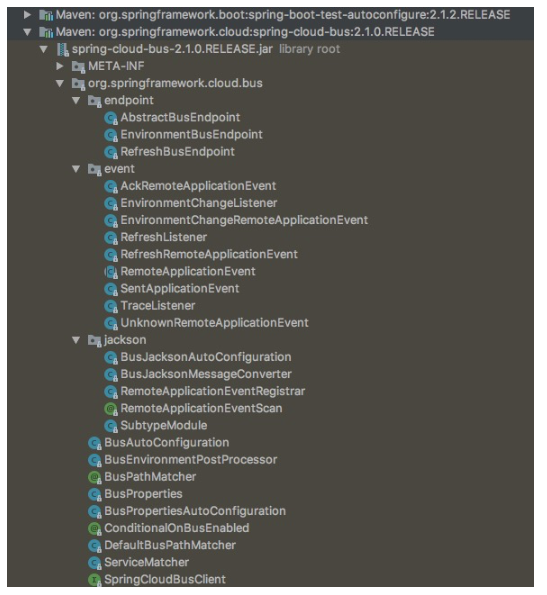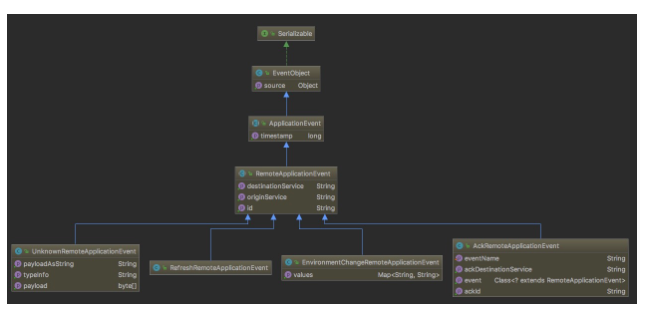In the previous article titled, Introduction to the Spring Cloud Stream System , we discussed about the details of the Spring Cloud Stream. In this article, we'll be discussing about another component of the Spring Cloud system. Spring Cloud Bus is positioned to be the message bus of the Spring Cloud system, which uses message broker to connect all nodes of the distributed system. The official Reference document of the Bus is very simple. It does not even have a picture.
The code structure of the latest Spring Cloud Bus (the code is short) is provided as follows:

Before we analyze how the Bus is implemented, let us take a look at two simple examples that uses the Bus.
The example of the Bus is relatively simple, because the default configuration is already available in the AutoConfiguration layer of the Bus. You only need to introduce the Spring Cloud Stream framework corresponding to the message middleware and dependencies of the Bus. After that, all running applications will use the same topic to receive and send messages.
The demo for the Bus has been uploaded to GitHub: https://github.com/fangjian0423/rocketmq-binder-demo/tree/master/rocketmq-bus-demo This demo initiates five nodes. If you add a new configuration item to any one of these five nodes, you add it to all of them.
Access the configuration-retrieving address provided by the controller of any node (the key is hangzhou):
curl -X GET 'http://localhost:10001/bus/env?key=hangzhou'The results returned by all nodes are all UNKNOWN, because the key hangzhou does not exist in the configuration of any node.
The Bus has a built-in EnvironmentBusEndpoint, which is used to add or update configuration through the message broker.
Access the endpoint (URL) of a node /actuator/bus-env? name=hangzhou&value=alibaba to add a new configuration item to this node (for example, access the URL of node1):
curl -X POST 'http://localhost:10001/actuator/bus-env?name=hangzhou&value=alibaba' -H 'content-type: application/json'Then access all nodes /bus/env to obtain the configuration:
$ curl -X GET 'http://localhost:10001/bus/env?key=hangzhou'
unknown%
~ ⌚
$ curl -X GET 'http://localhost:10002/bus/env?key=hangzhou'
unknown%
~ ⌚
$ curl -X GET 'http://localhost:10003/bus/env?key=hangzhou'
unknown%
~ ⌚
$ curl -X GET 'http://localhost:10004/bus/env?key=hangzhou'
unknown%
~ ⌚
$ curl -X GET 'http://localhost:10005/bus/env?key=hangzhou'
unknown%
~ ⌚
$ curl -X POST 'http://localhost:10001/actuator/bus-env?name=hangzhou&value=alibaba' -H 'content-type: application/json'
~ ⌚
$ curl -X GET 'http://localhost:10005/bus/env?key=hangzhou'
alibaba%
~ ⌚
$ curl -X GET 'http://localhost:10004/bus/env?key=hangzhou'
alibaba%
~ ⌚
$ curl -X GET 'http://localhost:10003/bus/env?key=hangzhou'
alibaba%
~ ⌚
$ curl -X GET 'http://localhost:10002/bus/env?key=hangzhou'
alibaba%
~ ⌚
$ curl -X GET 'http://localhost:10001/bus/env?key=hangzhou'
alibaba%You can see that a new configuration item has been added to all nodes. The key of the configuration item is hangzhou, and the value is alibaba. The configuration item is added through the EnvironmentBusEndpoint.
For example, set the destination to rocketmq-bus-node2 on node1 (spring.cloud.bus.id of node2 is set to rocketmq-bus-node2:10002, which matches the setting on node1) to modify the configuration:
curl -X POST 'http://localhost:10001/actuator/bus-env/rocketmq-bus-node2?name=hangzhou&value=xihu' -H 'content-type: application/json'Access /bus/env to obtain the configuration (the message is sent from node1, so the Bus also modifies the configuration of node1):
~ ⌚
$ curl -X POST 'http://localhost:10001/actuator/bus-env/rocketmq-bus-node2?name=hangzhou&value=xihu' -H 'content-type: application/json'
~ ⌚
$ curl -X GET 'http://localhost:10005/bus/env?key=hangzhou'
alibaba%
~ ⌚
$ curl -X GET 'http://localhost:10004/bus/env?key=hangzhou'
alibaba%
~ ⌚
$ curl -X GET 'http://localhost:10003/bus/env?key=hangzhou'
alibaba%
~ ⌚
$ curl -X GET 'http://localhost:10002/bus/env?key=hangzhou'
xihu%
~ ⌚
$ curl -X GET 'http://localhost:10001/bus/env?key=hangzhou'
xihu%You can see that only the configuration of node1 and node2 is modified, and that of the remaining three nodes remain unchanged.
Concepts
Event
A remote event RemoteApplicationEvent is defined in the Bus. This event inherits the event of Spring ApplicationEvent, and has four implementations:

Map<String, String> data, and inserts the data into the context environment of Spring. The Bus demo is completed by using this event in conjunction with EnvironmentBusEndpoint and EnvironmentChangeListener.AckRemoteApplicationEvent event upon successfully receiving a remote event.@RefreshScope annotation and all @ConfigurationProperties annotations to dynamically refresh the @Configuration class that is annotated by these annotations.The Bus also has a non-RemoteApplicationEvent - SentApplicationEvent: the message sending event. This event is used in conjunction with Trace to record the remote messages that have been sent.
All these events are used in conjunction with an ApplicationListener. For example, the EnvironmentChangeRemoteApplicationEvent is used in conjunction with EnvironmentChangeListener to add or update the configuration:
public class EnvironmentChangeListener
implements ApplicationListener<EnvironmentChangeRemoteApplicationEvent> {
private static Log log = LogFactory.getLog(EnvironmentChangeListener.class);
@Autowired
private EnvironmentManager env;
@Override
public void onApplicationEvent(EnvironmentChangeRemoteApplicationEvent event) {
Map<String, String> values = event.getValues();
log.info("Received remote environment change request. Keys/values to update "
+ values);
for (Map.Entry<String, String> entry : values.entrySet()) {
env.setProperty(entry.getKey(), entry.getValue());
}
}
}Call the EnvironmentManager#setProperty method to set the configuration upon receiving the EnvironmentChangeRemoteApplicationEvent from another node. This method sends an EnvironmentChangeEvent for each configuration item change, which is listened for by the ConfigurationPropertiesRebinder to perform the rebinding operation, and to add or update the configuration.
Actuator Endpoint
The Bus provides two Endpoints: EnvironmentBusEndpoint and RefreshBusEndpoint to add or update the configuration, or to refresh the global configuration. Their endpoint IDs or URLs are bus-env and bus-refresh respectively.
Configuration
Message sending in the Bus inevitably involves the Topic and Group information. Such content has been encapsulated in BusProperties. The default prefix is spring.cloud.bus. For example:
spring.cloud.bus.refresh.enabled is used to enable or disable the listener that listens for the global refresh event.spring.cloud.bus.env.enabled is used to enable or disable the endpoint for adding or updating the configuration.spring.cloud.bus.ack.enabled is used to enable or disable the sending of the AckRemoteApplicationEvent.spring.cloud.bus.trace.enabled is used to enable or disable the listener that listens for the Trace.The default topic for sending messages is springCloudBus, which can be changed through configuration. You can set the Group to the broadcasting mode, or set it to the latest mode by using UUID in conjunction with the offset.
Each Bus application has a unique Bus ID. The official format of the Bus ID is complex:
${vcap.application.name:${spring.application.name:application}}:${vcap.application.instance_index:${spring.application.index:${local.server.port:${server.port:0}}}}:${vcap.application.instance_id:${random.value}}We recommend that you set the Bus ID manually, because the destination of remote events of the Bus need to match the Bus ID.
spring.cloud.bus.id=${spring.application.name}-${server.port}Underlying analysis of the Bus
Underlying analysis of the Bus involves the following questions:
The BusAutoConfiguration automatic configuration class is annotated by the @EnableBinding(SpringCloudBusClient.class) annotation.
The usage of the @EnableBinding annotation has been specified in the previous article Knowledge sharing - Introduction to the Spring Cloud Stream system and how it works. Its value is SpringCloudBusClient.class, and it will create the DirectChannel message channel for the input and output methods in SpringCloudBusClient based on the source and sink interfaces:
public interface SpringCloudBusClient {
String INPUT = "springCloudBusInput";
String OUTPUT = "springCloudBusOutput";
@Output(SpringCloudBusClient.OUTPUT)
MessageChannel springCloudBusOutput();
@Input(SpringCloudBusClient.INPUT)
SubscribableChannel springCloudBusInput();
}The binding properties: springCloudBusInput and springCloudBusOutput can be changed by modifying the configuration file (for example, by modifying the topic):
spring.cloud.stream.bindings:
springCloudBusInput:
destination: my-bus-topic
springCloudBusOutput:
destination: my-bus-topicSend and receive messages
// BusAutoConfiguration
@EventListener(classes = RemoteApplicationEvent.class) // 1
public void acceptLocal(RemoteApplicationEvent event) {
if (this.serviceMatcher.isFromSelf(event)
&& !( event instanceof AckRemoteApplicationEvent)) { // 2
this.cloudBusOutboundChannel.send(MessageBuilder.withPayload(event).build()); // 3
}
}
@StreamListener(SpringCloudBusClient.INPUT) // 4
public void acceptRemote(RemoteApplicationEvent event) {
if (event instanceof AckRemoteApplicationEvent) {
if (this.bus.getTrace().isEnabled() && ! this.serviceMatcher.isFromSelf(event)
&& this.applicationEventPublisher ! = null) { // 5
this.applicationEventPublisher.publishEvent(event);
}
// If it's an ACK we are finished processing at this point
return;
}
if (this.serviceMatcher.isForSelf(event)
&& this.applicationEventPublisher ! = null) { // 6
if (! this.serviceMatcher.isFromSelf(event)) { // 7
this.applicationEventPublisher.publishEvent(event);
}
if (this.bus.getAck().isEnabled()) { // 8
AckRemoteApplicationEvent ack = new AckRemoteApplicationEvent(this,
this.serviceMatcher.getServiceId(),
this.bus.getAck().getDestinationService(),
event.getDestinationService(), event.getId(), event.getClass());
this.cloudBusOutboundChannel
.send(MessageBuilder.withPayload(ack).build());
this.applicationEventPublisher.publishEvent(ack);
}
}
if (this.bus.getTrace().isEnabled() && this.applicationEventPublisher ! = null) { // 9
// We are set to register sent events so publish it for local consumption,
// irrespective of the origin
this.applicationEventPublisher.publishEvent(new SentApplicationEvent(this,
event.getOriginService(), event.getDestinationService(),
event.getId(), event.getClass()));
}
}1. Use the Spring event listener to listen for all RemoteApplicationEvents received by the application. For example, bus-env sends the EnvironmentChangeRemoteApplicationEvent and bus-refresh sends the RefreshRemoteApplicationEvent to the application. All these events can be listened for by the listener.
2. Verify that an event received by the application is not an AckRemoteApplicationEvent (otherwise, the Bus will get stuck in an endless loop: it repeatedly receives and sends messages). Then verify that the event was sent by the application itself. If both conditions are met, perform Step 3.
3. Create a message by using the remote event as the payload. Then use the MessageChannel (the binding name of which is springCloudBusOutput) created by Spring Cloud Stream to send the message to broker.
4. Use the @StreamListener to annotate the MessageChannel (the binding name is springCloudBusInput) created by Spring Cloud Stream, and the message received is a remote message.
5. Assume that the remote event is an AckRemoteApplicationEvent, the trace feature is enabled, and the event was not sent by the application (indicating that it was sent by another application). If these conditions are met, send the AckRemoteApplicationEvent to the application to allow it to acknowledge that it has received a remote event sent by another application. Then the process ends.
6. If the remote event was sent by another application to the application, perform Step 7 and Step 8. Otherwise, perform Step 9.
7. If the remote event was sent by another application, send the event to the application. If application has already been processed by the corresponding message recipient, you do not have to send the event to the application again.
8. If you have enabled the AckRemoteApplicationEvent, create an AckRemoteApplicationEvent and send this event to all applications. The reason for sending the event to the application is that you did not send the AckRemoteApplicationEvent to the application. As a result, the application did not acknowledge the receipt of the event that was sent by itself. The reason for sending the event to other applications is that the application needs to inform other applications that it has received the message.
9. If you have enabled Trace, create and send the SentApplicationEvent to the application.
After bus-env is triggered, the EnvironmentChangeListener of all nodes will detect the configuration change, and controllers of all these nodes will print the following information:
o.s.c.b.event.EnvironmentChangeListener : Received remote environment change request. Keys/values to update {hangzhou=alibaba}If you listen for AckRemoteApplicationEvent on the current node, you will receive information from all nodes. For example, the AckRemoteApplicationEvent listened for on node5 is as follows:
ServiceId [rocketmq-bus-node5:10005] listeners on {"type":"AckRemoteApplicationEvent","timestamp":1554124670484,"originService":"rocketmq-bus-node5:10005","destinationService":"**","id":"375f0426-c24e-4904-bce1-5e09371fc9bc","ackId":"750d033f-356a-4aad-8cf0-3481ace8698c","ackDestinationService":"**","event":"org.springframework.cloud.bus.event.EnvironmentChangeRemoteApplicationEvent"}
ServiceId [rocketmq-bus-node5:10005] listeners on {"type":"AckRemoteApplicationEvent","timestamp":1554124670184,"originService":"rocketmq-bus-node1:10001","destinationService":"**","id":"91f06cf1-4bd9-4dd8-9526-9299a35bb7cc","ackId":"750d033f-356a-4aad-8cf0-3481ace8698c","ackDestinationService":"**","event":"org.springframework.cloud.bus.event.EnvironmentChangeRemoteApplicationEvent"}
ServiceId [rocketmq-bus-node5:10005] listeners on {"type":"AckRemoteApplicationEvent","timestamp":1554124670402,"originService":"rocketmq-bus-node2:10002","destinationService":"**","id":"7df3963c-7c3e-4549-9a22-a23fa90a6b85","ackId":"750d033f-356a-4aad-8cf0-3481ace8698c","ackDestinationService":"**","event":"org.springframework.cloud.bus.event.EnvironmentChangeRemoteApplicationEvent"}
ServiceId [rocketmq-bus-node5:10005] listeners on {"type":"AckRemoteApplicationEvent","timestamp":1554124670406,"originService":"rocketmq-bus-node3:10003","destinationService":"**","id":"728b45ee-5e26-46c2-af1a-e8d1571e5d3a","ackId":"750d033f-356a-4aad-8cf0-3481ace8698c","ackDestinationService":"**","event":"org.springframework.cloud.bus.event.EnvironmentChangeRemoteApplicationEvent"}
ServiceId [rocketmq-bus-node5:10005] listeners on {"type":"AckRemoteApplicationEvent","timestamp":1554124670427,"originService":"rocketmq-bus-node4:10004","destinationService":"**","id":"1812fd6d-6f98-4e5b-a38a-4b11aee08aeb","ackId":"750d033f-356a-4aad-8cf0-3481ace8698c","ackDestinationService":"**","event":"org.springframework.cloud.bus.event.EnvironmentChangeRemoteApplicationEvent"}Now, let us answer the four questions that are listed in the begining of this section:
springCloudBus topic by using the BusAutoConfiguration#acceptLocal method through Spring Cloud Stream.springCloudBus topic by using the BusAutoConfiguration#acceptRemote method through Spring Cloud Stream.BusAutoConfiguration#acceptRemote method.RemoteApplicationEvent on the current node based on the Spring event mechanism. For example, the EnvironmentChangeListener receives the EnvironmentChangeRemoteApplicationEvent, and the RefreshListener receives the RefreshRemoteApplicationEvent.The Spring Cloud Bus does not have too much content. However, you need to first understand the Spring Cloud Stream system and the Spring event mechanism before you can sufficiently understand how the Bus processes local and remote events.
Currently, the Bus provides only a few built-in remote events, most of which are configuration related. We can use the RemoteApplicationEvent in conjunction with the @RemoteApplicationEventScan annotation to build our own microservice message system.
Fang Jian (nickname: Luoye), GitHub ID @fangjian0423, open-source fan, Alibaba Cloud senior development engineer, developer of Alibaba Cloud EDAS. Fang Jian is one of the owners of the open-source Spring Cloud Alibaba project.

2,593 posts | 790 followers
FollowAlibaba Developer - October 22, 2021
Alibaba Developer - August 19, 2021
Alibaba Clouder - March 27, 2019
Alibaba Clouder - May 17, 2019
Alibaba Cloud Native - April 13, 2021
Alibaba Clouder - December 19, 2019

2,593 posts | 790 followers
Follow EDAS
EDAS
A PaaS platform for a variety of application deployment options and microservices solutions to help you monitor, diagnose, operate and maintain your applications
Learn More Container Service for Kubernetes
Container Service for Kubernetes
Alibaba Cloud Container Service for Kubernetes is a fully managed cloud container management service that supports native Kubernetes and integrates with other Alibaba Cloud products.
Learn More Container Registry
Container Registry
A secure image hosting platform providing containerized image lifecycle management
Learn MoreMore Posts by Alibaba Clouder